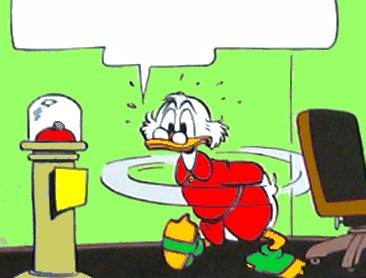

Carl Barks was a highly-gifted creator all
of his adult life. Some people tend to think of him 'only' as a
brilliant and inventive storyteller, but he was creative in many
other fields as well. It is true that without a Barks on their
payroll his publisher Western (and for that matter Disney as well)
would have faced serious difficulties on the comic book market,
because he must be seen as the primary incentive behind the books'
hastily growing success after several meager years. This was
caused by a combination of a number of different ingredients (good
stories, new characters ... ) which Barks handled with incredible
virtuosity.
In several interviews Barks expressed that he would have liked to
be an inventor if all else had failed. In this statement lies the
seed to his astonishing inventiveness during his actual career -
he was always on the lookout for something new and interesting to
occupy himself. An early example showing Barks' excellence in
creating complicated inventors' scenarios was published in a
local newspaper as far back as in 1948 (see it HERE, second paragraph).
It is almost Gyro Gearloosean in its approach - four years before
the absent-minded chicken character himself appeared in Barks'
panels.
So, beside all the suitable titles posterity could rightfully attach to Barks the honorary title of Creator might be one of the most merited...
 |
Storyteller
creations Barks always took the trouble to
deliver something extra for his comic book readers: |
| Professional
creations In those days comic book artists
did not experiment with their medium as it is done
frequently nowadays - but Barks did! He was not afraid to
introduce new creations in the field of special panels.
He did it simply because his stories often called for
something different in order to present a plot or an
action in a more precise way than a normal square panel
could master. That way he could make the necessary room
for the characters in certain positions. |
| Painting
creations When Barks started painting the
ducks he was forced to use techniques miles away from his
comic book work: I figured: 'I'm going to do away
with the outline on the ducks. They won't look like
colored cartoons; I'm going to see if I can't make them
look like real, round ducks. I wouldn't draw outlines if
I was painting a bunch of sailors - I would draw them
with colors. And I did that with the ducks. |
 |
Personal
creations Barks never ran out of ideas that
called for a certain creativity on the more personal
level. Here are three examples: |
This website has numerous detailed pages demonstrating Barks' masterly creativity. Here are some examples: THE FIRSTS |
| http://www.cbarks.dk/THECREATOR.htm | Date 2006-09-10- |